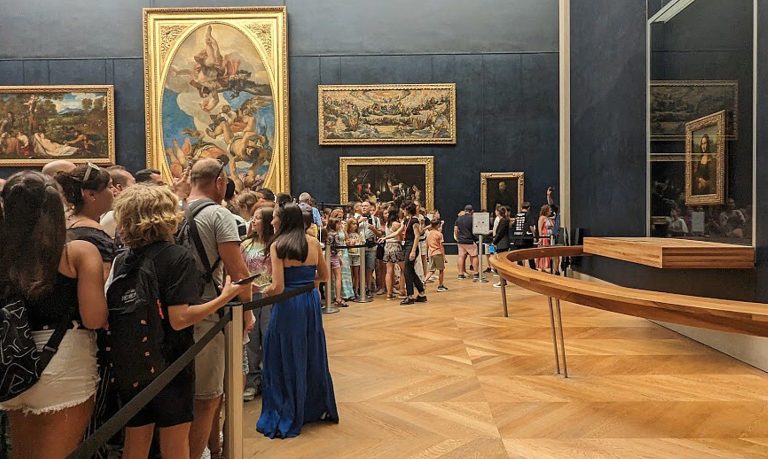
By Karen Rubin, Travel Features Syndicate, goingplacesfarandnear.com
If you are planning to visit Paris his year, it is especially important to make plans really early, lock in reservations to visit the sites, attractions, restaurants, hotels, even train or bus transportation you most want to include if you are going outside Paris.
Paris (with 85,000 hotel rooms) is expecting about 15 million visitors as it hosts the Olympics (July 26-August 11) and Paralympics (August 28-Sept. 8. Other events to keep in mind: Tour de France, from June 29 to July 21; and Tour de France Femmes, from August 12 to 18.
The fact is, Paris is so popular (for good reason), there is no longer the “shoulder” season or “off season” (especially as more travelers seek the comparative comfort of cooler seasons, known as “coolcationing”). No matter when you travel, to get the most out of your visit, it is essential to do pre-planning. The days of just strolling into the major attractions are well gone, so advance purchase of timed- and capacity-controlled tickets will still be essential. Book online as soon as you know your dates of travel. In that way, you can avoid wasting valuable time and money waiting on line for tickets (followed by the line for security). Moreover, having a set time to visit the key attraction on your list will help you structure your day – while still allowing for serendipitous experiences and discoveries.
I must admit that my decision to spend four days in Paris at the end of my European Waterways canal boat cruise in the Alsace-Lorraine was a bit spontaneous and I didn’t have as much time as I would have liked to do the research and preparation which I am recommending here. (So I didn’t get to go up the Arc de Triomphe or the Eiffel Tower.) And planning out my visit for a city as big (and yet, as I found, not so big that I couldn’t walk everywhere), with as many highlights, was intimidating from a logistics point of view. So I began as I would hope other travelers do: I consulted what other travel writers have written about “four days” in Paris, and checked the various lists of “top attractions” like on tripadvisor.com.
Listen, while most travel writers will focus on the “off the beaten track” and “hidden gems” and “local favorites,” if, like me, you haven’t been to Paris in eons or ever, you want to experience what everyone else is talking about. They are the top attractions for a reason. But by preparing in advance in order to reduce wasting time waiting on lines, you will (I guarantee) have those serendipitous discoveries of “hidden gems” and “less known” that you can then boast discovering.
I had my list of top attractions, but how to organize in the best way?
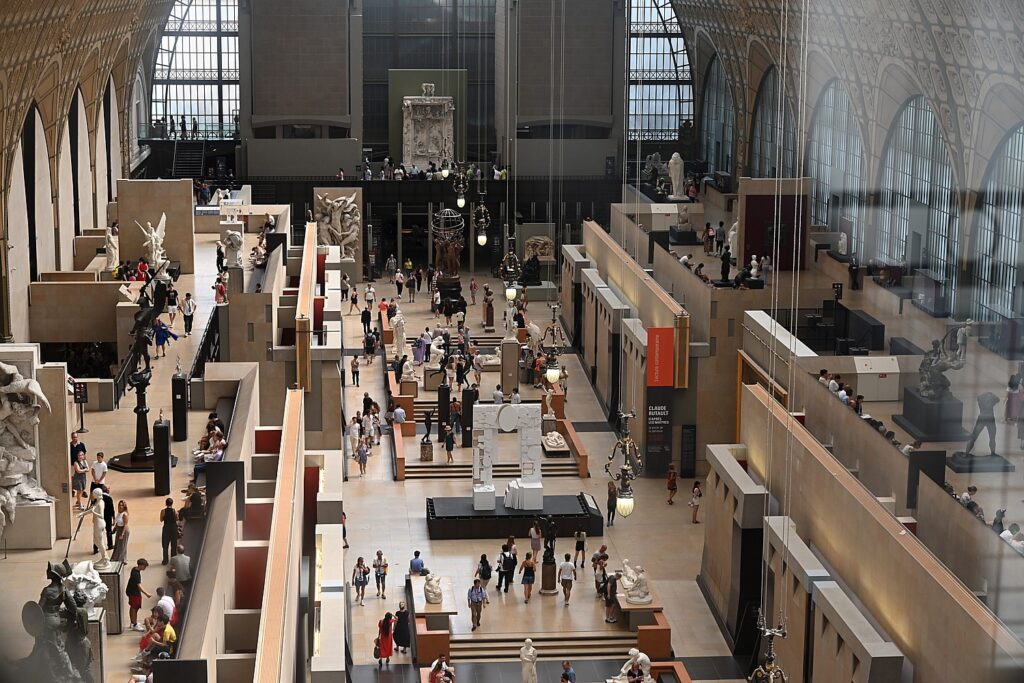
I started with figuring out the priority attractions – Le Louvre, Musee D’Orsay – that would require advance, timed tickets, and made each of them the centerpiece of a day. Musee D’Orsay is closed on Monday; Le Louvre is closed on Tuesday. Then I looked to what was around, but much of how I spent my day after was pretty spontaneous.
The city was hopping with visitors this year – as tourism recovered globally after pandemic closures and it seems the world decided never to put off again their dream destinations. I visited in late August, a very busy time in any year, and the city is already preparing for the Olympics (I happened upon a city-wide practice run for security street closures.)
And most surprising to me, was how easy it is to get around Paris – especially walking and by bicycle (with loads of bicycle share stations), with its special biking lanes and traffic signals, and traffic signals and crossings that favor pedestrians. For those who prefer, the superb metro and bus system has multi-day tickets.
I walked everywhere – because it is the whole of Paris that is the attraction – the architecture, the people, the street activity, and the sheer beauty of the city, absolutely one of the most beautiful, enchanting in the world. And not just around the stunning sites of the Eiffel Tower, Le Louvre, Musee D’Orsay and Notre Dame (which you can see as it is restored), but neighborhoods that are so picturesque, interesting, and full of character. So I plot the walking time into my day.
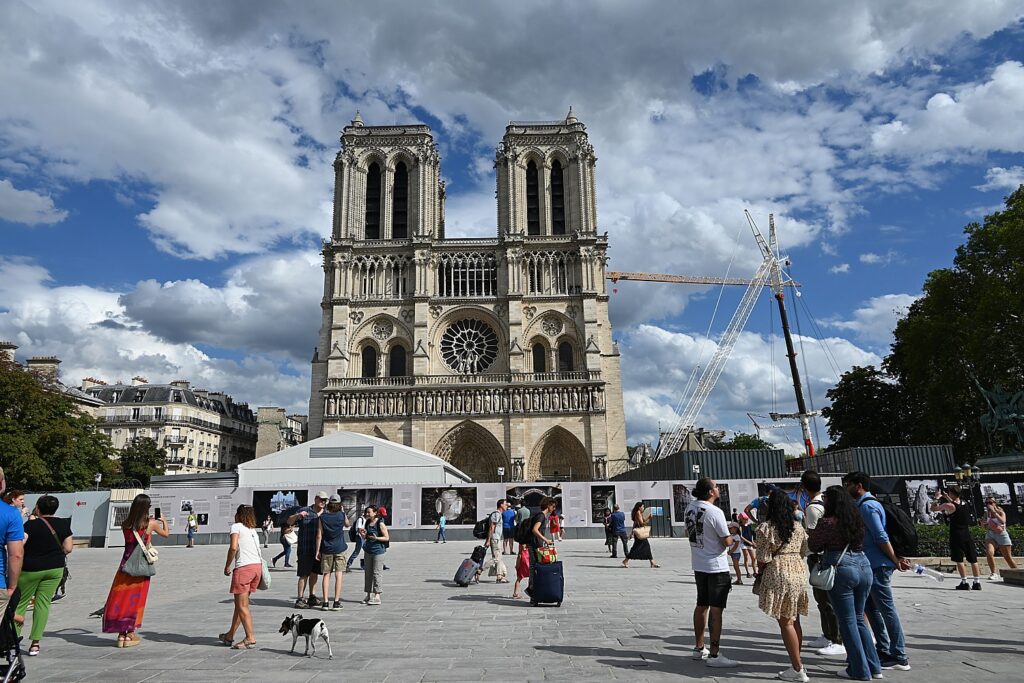
But walking around, is the best way to come upon those “hidden gems” that no one else knows about. You have a cascade of serendipitous experiences, compelling places and surprises around every corner. It’s like surrendering yourself to the universe, or in this case, the city, and let it find you. And sometimes, when you set out in search for something, all these other things emerge.
(GPS is only helpful when you already have internet, but you should plot your route and then download so you have the maps offline or at least download the Paris map, which I kept forgetting to do, so I often relied on actual maps and the kindness of wonderful strangers, even with my very limited French, to point me in the right direction.)
During my four days in Paris, I visited:
Arrival afternoon:
Arc de Triomphe
Stroll the quais along the Seine for the magnificent views of Eiffel Tower at sunset into the night
Day 1: (Sunday)
Musee D’Orsay
Isle de la Cite (to see the restoration of Notre Dame)
Sainte-Chappelle
Tuileries Gardens
Place de la Concorde
Stroll the quai along the Seine to the Eiffel Tower at night
*
Day 2 (Monday)
Le Louvre
Notre Dame (again)
Isle de France
Marais District/Holocaust Memorial
*
Day 3 (Tuesday)
Marais District/Holocaust memorials
Place des Vosges
Museum of Paris History (a highlight)
Musee d’Art D’Histoire du Judaism
Musee Picasso-Paris
Bastille monument
Place Royale
*
Day 4 (Wednesday)
Montmartre
Musee Montmartre
Dali Gallery
Sacre Coeur
(Not on my list: Versailles, which I visited many years ago but any first-timer should visit)
And here are my regrets at having missed out: Victor Hugo’s House (turns out I was right there but didn’t know to look); Petit Palais which has marvelous exhibits (couldn’t time it right); the Crype Archeologique de L’Ile de la Cite (right beside the Notre Dame, but I never time it right to visit); and Catacombs (intriguing!). And yes, I regret not climbing the stairs up the Eiffel Tower (didn’t realize you can get that ticket on the spot) and seeing the museum and climbing inside the Arc de Triomphe
Yes, these are the most popular sites, but they are popular for very good reason, and if you are not a frequent visitor to Paris, you would be doing yourself a disservice not to experience them yourself. But there are ways to make the experience your own. Your list of “highlights” might be different – like the bateaux mouches cruise on the Seine (included in the Paris attractions pass).
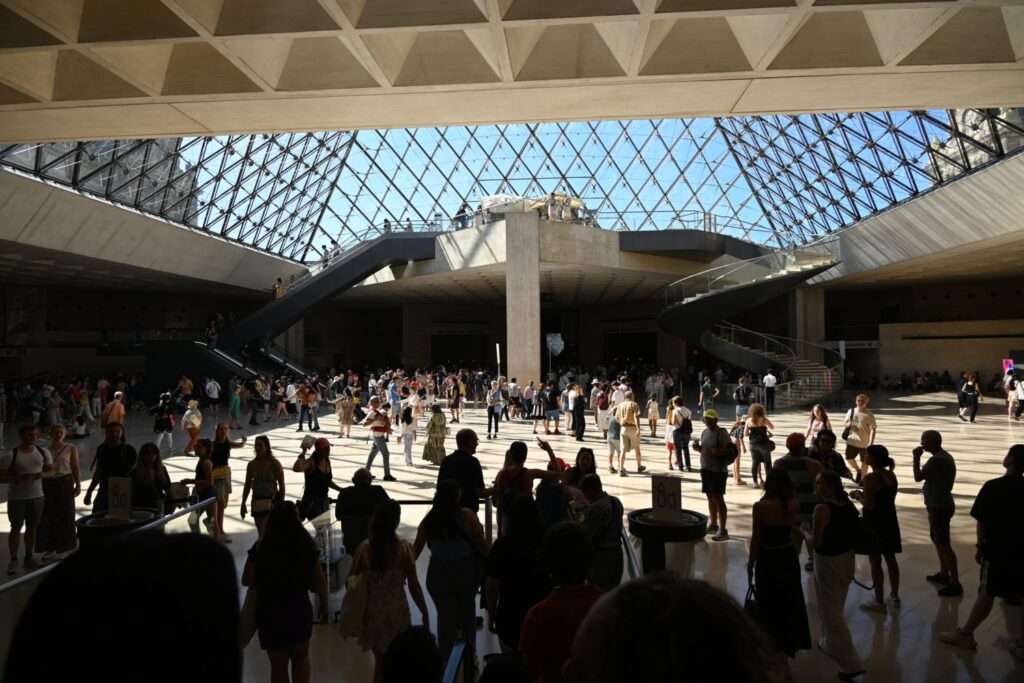
I highly recommend getting the Paris Museum Pass (https://www.parismuseumpass.fr/t-en, which provides admissions to 34 museums in Paris and 11 more in the region) or the Paris Pass (parispass.com) which not only makes attractions and experiences more affordable, but will absolutely add to what you see and do, and also provides such helpful information as hours, location, proximity to where you are. When booking, try to book the earliest available times or evening times, and midweek over weekend.
You are likely to arrive in Paris at the Charles de Gaulle Airport, which has easy train connection to downtown – purchase your metro ticket in advance at a wonderful visitor information office as you walk out, and even a multi-day ticket. This will cut down on wasted time waiting on line to buy a ticket and the confusion of knowing what zone you need. And it saves quite a lot of money. But the best part is you don’t think about how much you are spending – it all seems free.
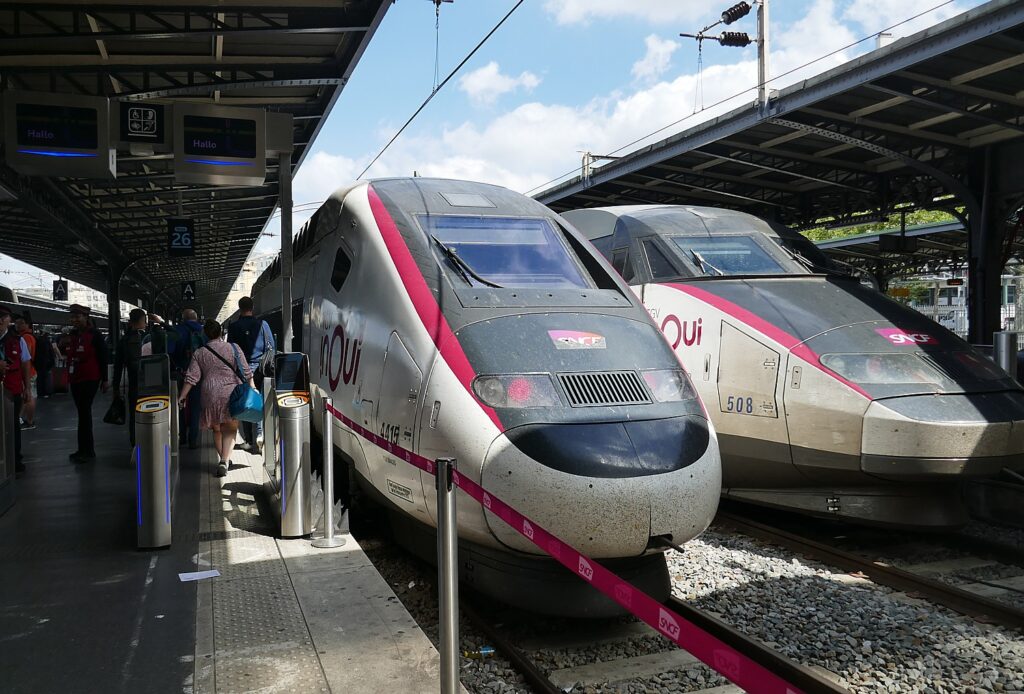
Coming from Strasbourg by train at the end of my six-day canal cruise of the Alsace Lorraine aboard European Waterways’ Panache, I arrived at Gard d’Est and made my way on the metro (after going in the wrong direction on the metro) to a stop just in front of the Arc de Triomphe. My hotel, the Hotel Napoleon Paris, a five-star boutique hotel which put me perfectly into the atmosphere of Napoleon’s Empire period, is not even a half-block away, and one boulevard over from the magnificent Champs Elysee. (Note: book train tickets in advance, www.raileurope.com)
It was afternoon, and I quickly checked in to this charming boutique hotel, dropped my bag, and went out to explore the Arc de Triomphe.
Arc de Triomphe
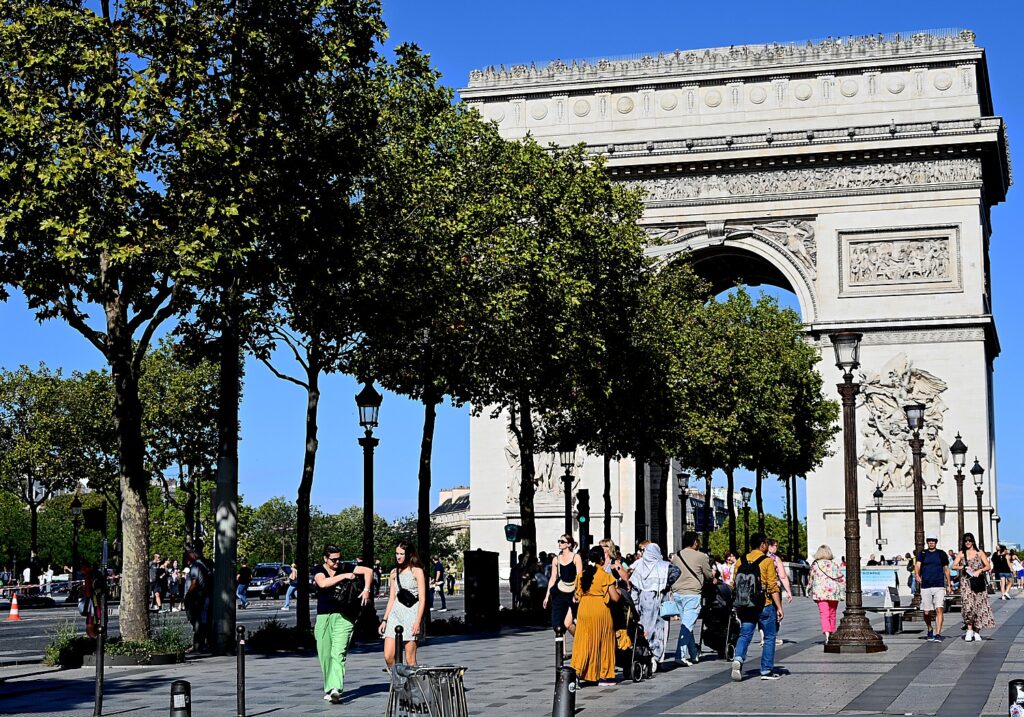
This iconic symbol of France is set in the middle of a roundabout (the Place D’Etoile, like a star”) where 12 busy boulevards converge, including the magnificent Champs Elysee which is aligned with its center. Don’t even think about trying to cross the roundabout – you must walk through underground passageways to get across the busy boulevards that encircle the monument (There’s a pedestrian tunnel at Place Charles de Gaulle on the north side of the Champs-Élysées that will take you down to the arch.)
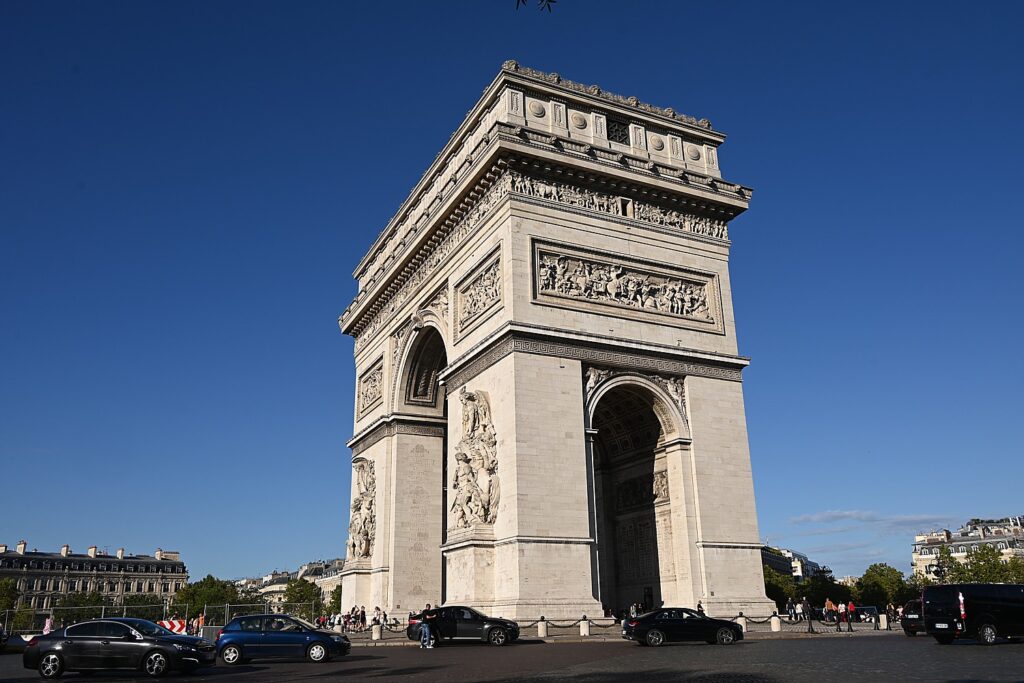
Building the Arc de Triomphe began in 1806 on Napoleon’s orders. Just a year earlier, in 1805, Napoleon’s forces won a decisive victory over Russian and Austrian troops at the Battle of Austerlitz. French architect Jean-François-Thérèse Chalgrin took his inspiration from the great arches of the world and designed Triomphe to be the largest in the world. The arch is 164 feet tall, and twice a year, the sun sets directly in the center. It took 30 years to complete the arch which was officially opened by King Louis-Phillipe on July 29, 1836.
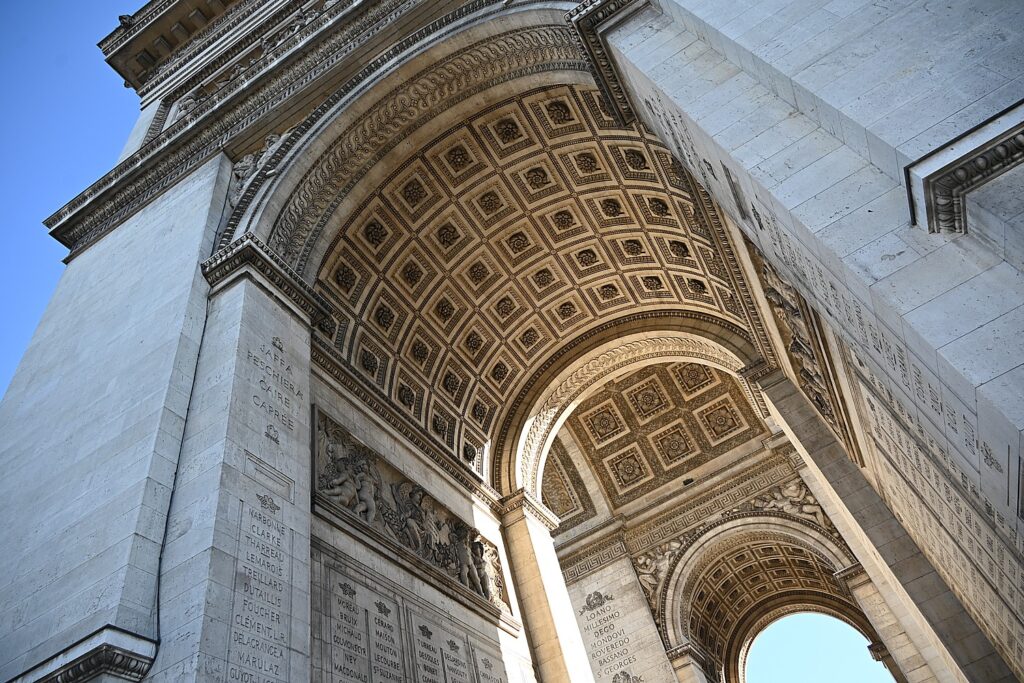
In the years since, soldiers have marched past the arch as a victory lap – France and its allies did in 1918, 1944 and 1945; Germany in 1871 and 1940. Every year, a ceremony at the Tomb of the Unknown Soldier, buried below the arch, marks the anniversary of the armistice signed on Nov. 11, 1918.
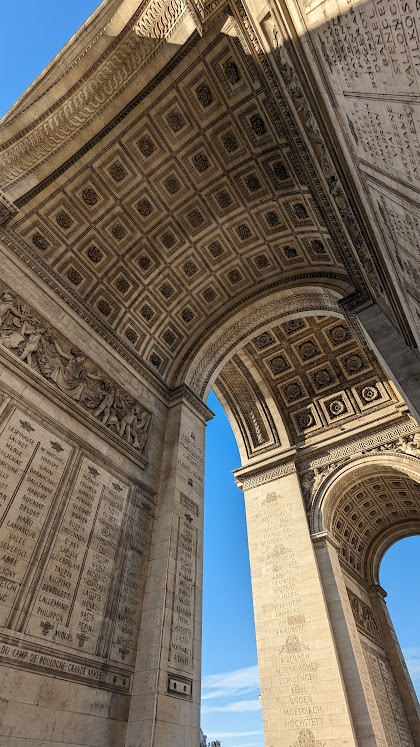
Today, the Arc de Triomphe is more of a symbol of peace and is very recognizable as the end point for the Tour de France cyclists. For the French, the Arc de Triomphe goes well beyond being commemorative, but is foundational in the French national psyche.
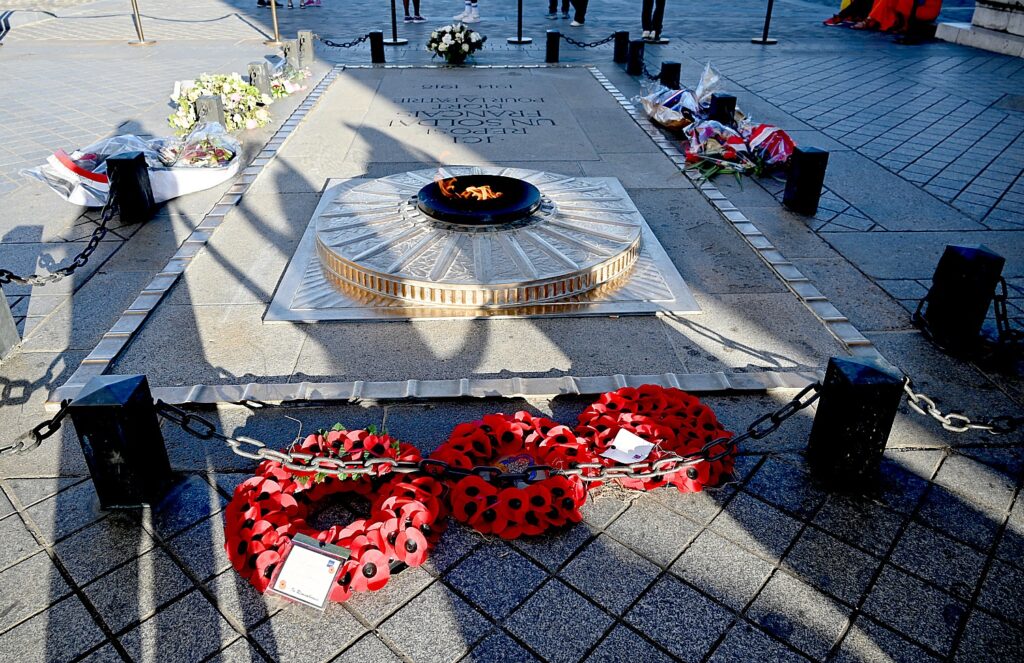
In 1921 the Tomb of the Unknown Soldier was incorporated into the monument, and today the tomb’s flame is rekindled every evening at 6.30 p.m. to show respect for All of France’s fallen.
One such event was just winding up as I arrived.
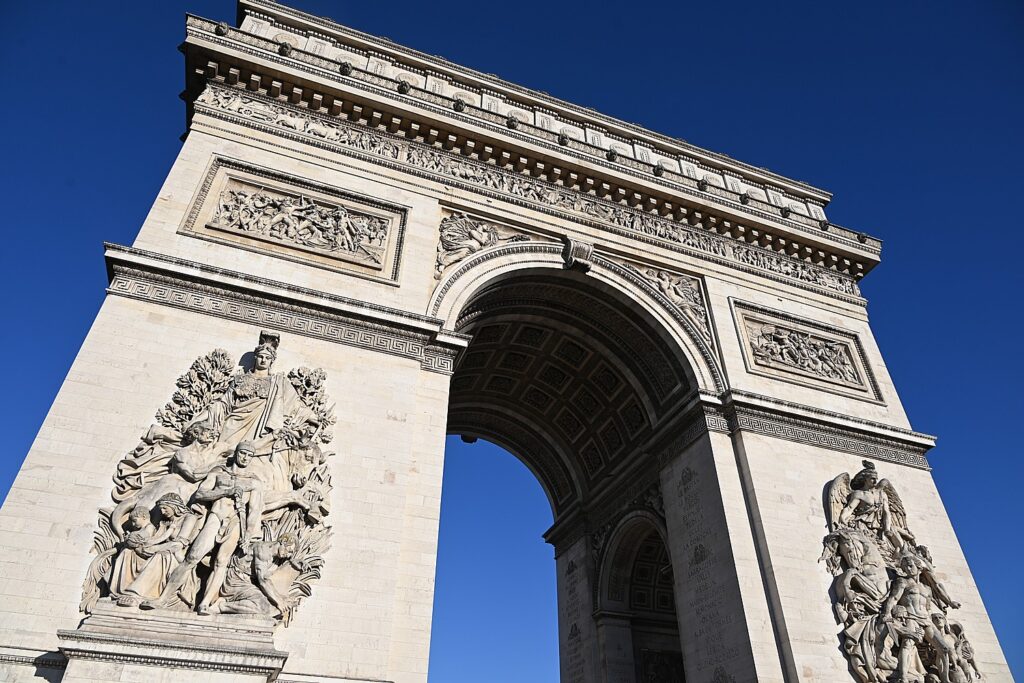
I was transfixed by the arch, the spectacular bas-reliefs of historic events that grace each pillar – The Entry of Napoleon, The Conquest of Alexandria and The Battle of Austerlitz. The most famous of them, The Departure of the Volunteers, also known as La Marseillaise, was created by the Romantic sculptor François Rude in 1792. The others were crafted by two other sculptors, Antoine Etex and Jean-Pierre Cortot Plaques list the names of hundreds of generals and battles.
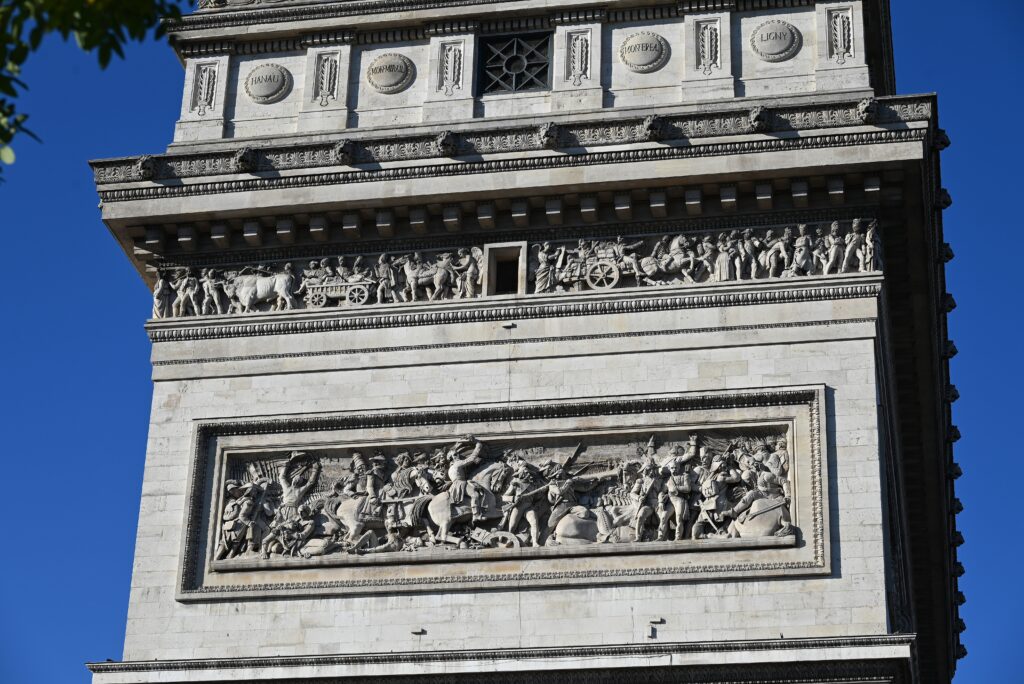
Admittedly, I didn’t know that you could enter the monument and climb the 284 steps to to the terrace (an elevator is available for those who require it) for a view, or that there is a museum inside – The Permanent ‘Great Moments of French History’ exhibition which traces the story of the Arc de Triomphe and explains the architecture, friezes and sculptures. So I definitely did not book tickets in advance. But the line to purchase tickets was ridiculous so I happily contented myself to just study the stunning reliefs and be transfixed by the arch’s form. (Having a Paris Museum Pass would have provided free admission without the need to reserve a time.)
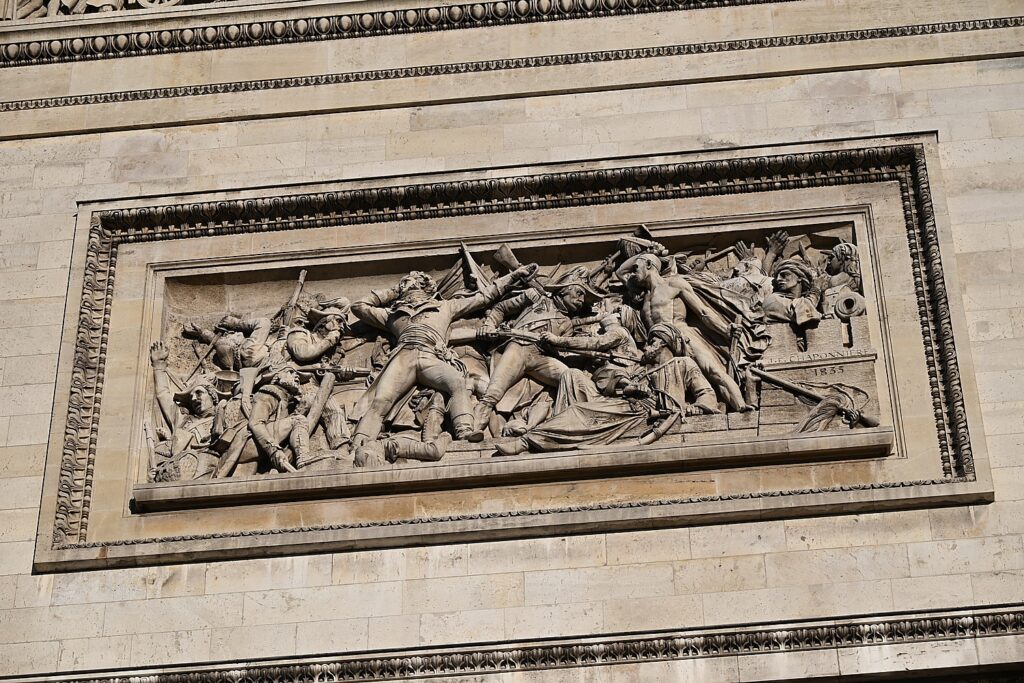
What I missed though was the dramatic view from the top: looking down the Champs-Élysées to the Louvre, out to La Defense, around to the Eiffel Tower. And you look straight down at one of the world’s largest round-abouts, where the 12 avenues come together.
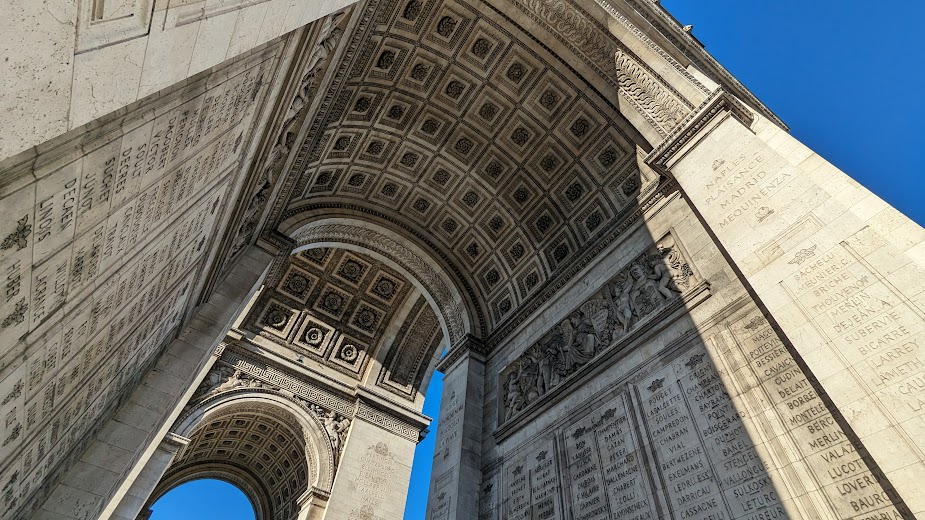
You can purchase tickets in advance; the Arch is also included on the Paris Museum Pass http://en.parismuseumpass.com/
I continued my walk well into the evening, following the route the concierge at the Hotel Napoleon laid out for me: strolling down the Champs Elysee, turning onto the Avenue George V (and passed the famous Hotel George V), to the Seine.
Paris is truly magical, truly the City of Light and romance. Couples walk along the quai, attach a lock to just about any wrought iron they can find, pose for a selfie.
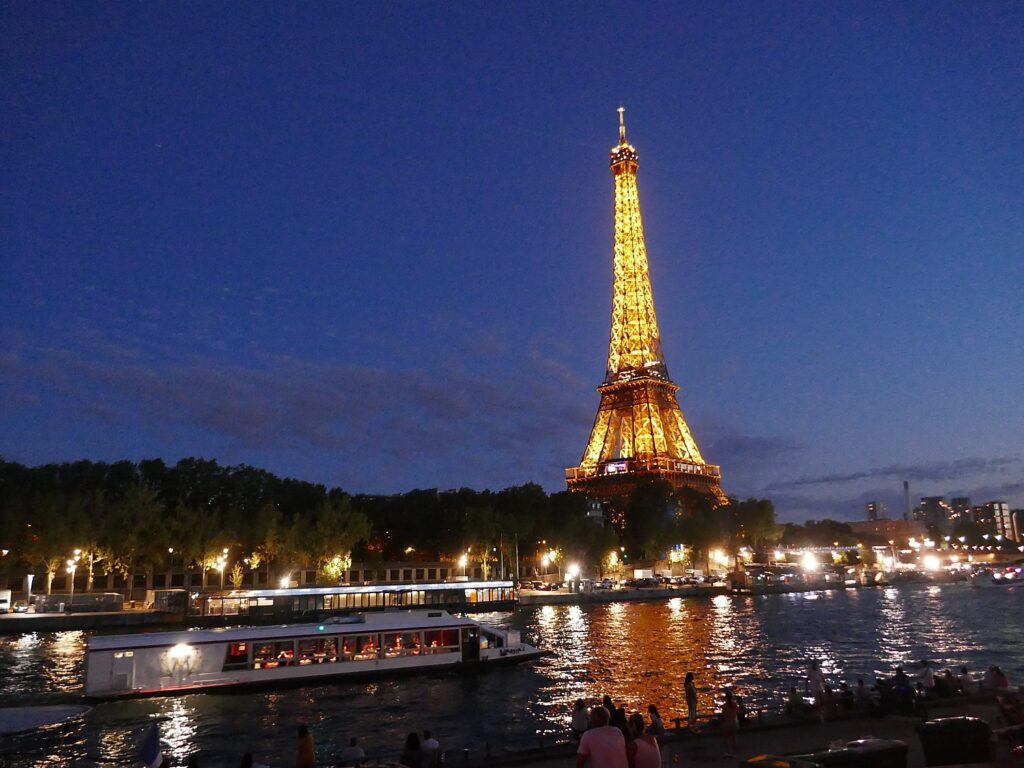
That first view of the Eiffel tower from across the Seine, the bateaux mouches sailing by (I’m seeing Audrey Hepburn and Cary Grant in “Charade”) as the sky takes on the rosy tones of sunset, fills you with a giddiness that can be described as joie de vivre. By the time I headed back along the quai, passing couples in amorous embraces, night has descended and the views of the lighted tower, bridges, and reflections on the river take your breath away.
Walking back to the Hotel Napoleon on a tony residential street just off the Champs Elysee, I felt more like I am going back to my swank Parisian apartment rather than a hotel. I get another view of the Arc de Triomphe as I turn the corner.
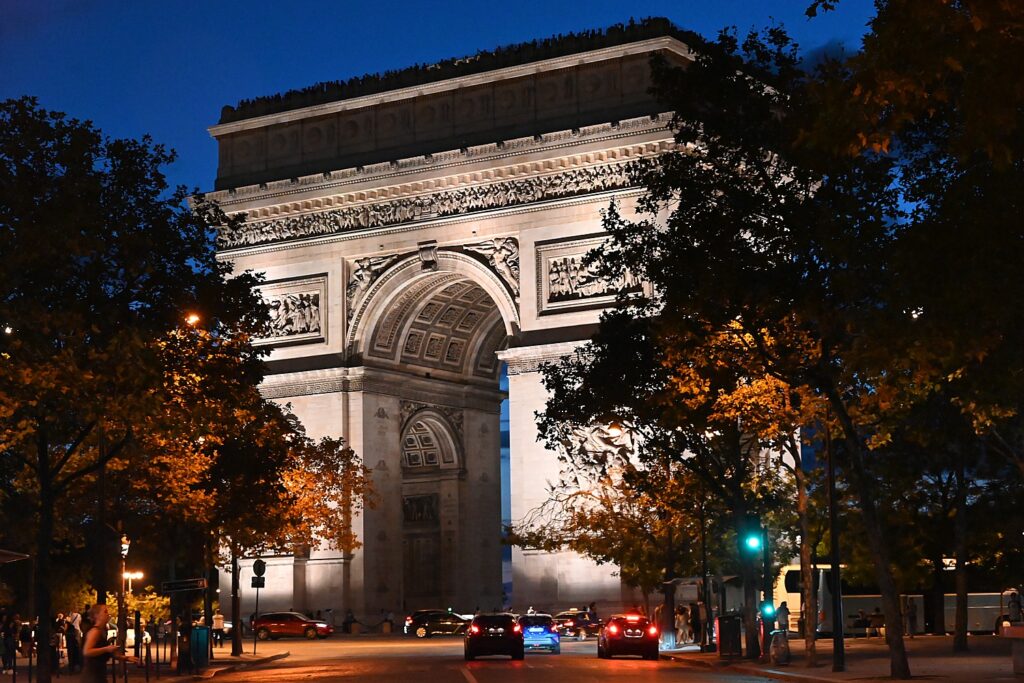
Hôtel Napoléon Paris 5,40, av. de Friedland 75008 Paris, Direct phone +33156684480, www.hotelnapoleon.com, https://www.historichotels.org/hotels-resorts/hotel-napoleon-paris/, https://preferredhotels.com/hotels/france/hotel-napoleon-paris
More planning help from the Paris Tourist Office, https://parisjetaime.com/eng/. Online ticketing at https://parisjetaime.com/eng/tickets.
For Olympics planning (and where you can purchase tickets that become available), https://www.paris2024.org/en/
Next: Musee D’Orsay Highlights Day 2 in Paris
See also:
ROMANCE IS AT THE HEART OF THE HOTEL NAPOLEON IN PARIS, CITY OF LOVE
_______________________
© 2024 Travel Features Syndicate, a division of Workstyles, Inc. All rights reserved. Visit goingplacesfarandnear.com and travelwritersmagazine.com/TravelFeaturesSyndicate/. Blogging at goingplacesnearandfar.wordpress.com and moralcompasstravel.info. Visit instagram.com/going_places_far_and_near and instagram.com/bigbackpacktraveler/ Send comments or questions to FamTravLtr@aol.com. Tweet @TravelFeatures. ‘Like’ us at facebook.com/NewsPhotoFeatures






